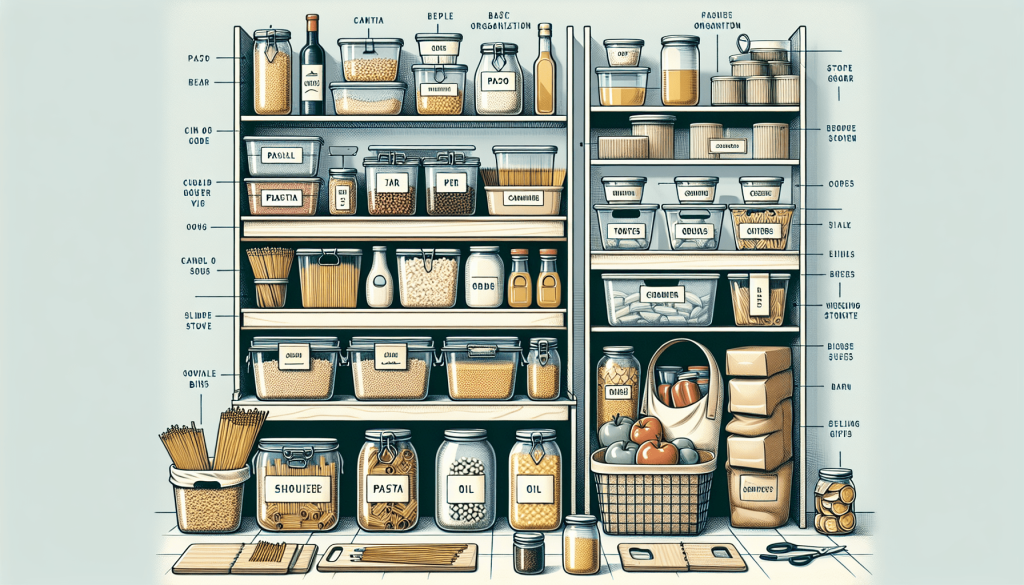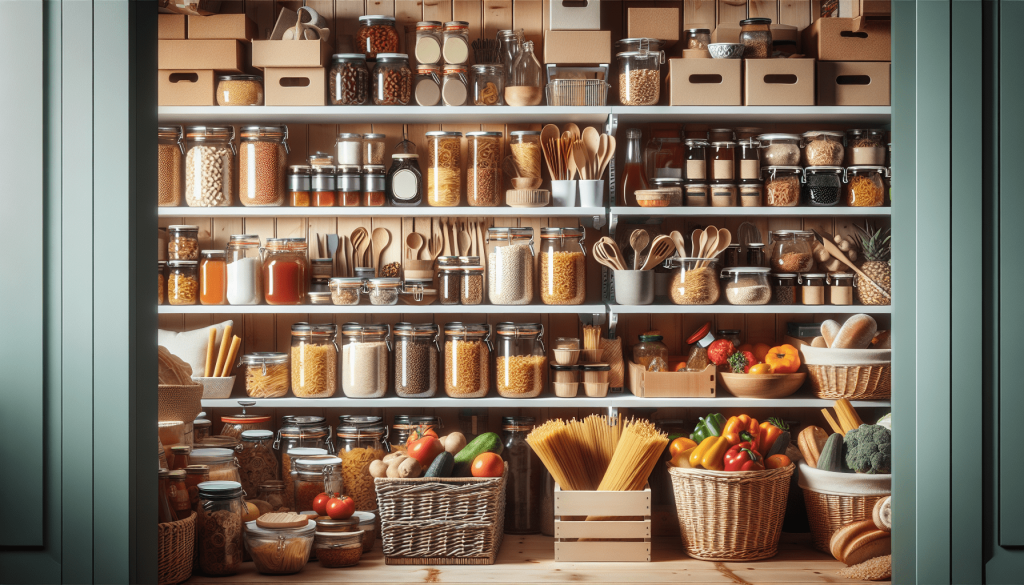In today’s fast-paced world, having a well-organized pantry can make all the difference when it comes to meal prep and saving time. Whether you’re a seasoned home cook or just starting out, finding the best ways to store pantry items for easy access is essential. With shelves neatly arranged and items visible at a glance, you’ll never have to rummage through cluttered cupboards again. From clever storage solutions to practical tips, this article will guide you through the journey of transforming your pantry into a streamlined and efficient space that not only looks great but also makes your cooking experience a breeze. Say goodbye to the frustration of searching for that elusive spice or ingredient, and hello to hassle-free and efficient pantry storage.
Use Clear Containers
Benefits of using clear containers
Using clear containers in your pantry has several benefits. Firstly, clear containers allow you to see the contents at a glance, making it easier to find what you need without rummaging through shelves. This saves you time and eliminates guesswork. Additionally, clear containers help to keep your pantry organized and visually appealing. With everything neatly stored in transparent containers, your pantry will look neat and tidy. Lastly, clear containers are stackable, maximizing storage space and making it easier to maintain an organized pantry.
How to choose the right clear containers
When selecting clear containers for your pantry, there are a few key factors to consider. Firstly, opt for containers that are made from high-quality, food-safe materials. Look for containers that are BPA-free and easy to clean. It’s also important to choose containers that are the right size for your pantry shelves. Measure the depth and width of your shelves beforehand to ensure a perfect fit. Additionally, consider containers that come with airtight lids to keep pantry items fresh and prevent pests from getting in.
Labeling tips for clear containers
Labeling your clear containers is a crucial step in ensuring an organized pantry. Use a label maker or waterproof markers to clearly identify the contents of each container. Be specific and include the expiry date if applicable. Consider using a consistent labeling system and make sure the labels are easily readable. For a more uniform look, use the same font and label position on all your containers. Regularly review and update labels to avoid confusion and maintain a well-organized pantry.
Utilize Storage Bins
Benefits of using storage bins
Storage bins are a fantastic addition to any pantry, offering numerous benefits. Firstly, using storage bins helps to separate different types of pantry items, making it easier to locate specific items quickly. By categorizing items such as snacks, grains, and canned goods into separate bins, you can avoid clutter and save time. Secondly, storage bins provide a protective barrier against potential spills or leaks from pantry items. This prevents messes from spreading and keeps your pantry clean and organized.
Different types of storage bins
When choosing storage bins for your pantry, you’ll come across various options. Plastic storage bins are a popular choice due to their durability and affordability. Look for bins with built-in handles for easy handling and transportation. Another option is wire baskets, which provide a more rustic and open storage solution. They allow air circulation, which can be beneficial for items that require ventilation. Finally, collapsible storage bins are a great choice if you have limited space. These bins can be easily folded and stacked when not in use.
Organizing pantry items with storage bins
To effectively utilize storage bins in your pantry, begin by sorting pantry items into categories. Keep similar items together, such as canned goods in one bin and baking ingredients in another. Use smaller bins within larger ones to further separate items. Label each bin clearly to avoid confusion. Place the most frequently used items in easily accessible bins, while lesser-used items can be stored in higher or harder-to-reach bins. Regularly review and adjust the organization system as your pantry stock changes.

Invest in Shelf Organizers
Benefits of using shelf organizers
Shelf organizers are a game-changer when it comes to maximizing space and maintaining an organized pantry. One significant benefit of using shelf organizers is that they create additional storage space by utilizing vertical space effectively. By doubling or even tripling the usable space on each shelf, you can store more pantry items without sacrificing accessibility. Additionally, shelf organizers provide stability to prevent items from toppling over and help maintain a neat appearance.
Types of shelf organizers
There are various types of shelf organizers available to suit different pantry needs. Adjustable shelf organizers are versatile as they can be easily customized to fit different shelf sizes. They can be extended or contracted to match the length and height of your pantry shelves. Another option is stackable shelf organizers. These organizers allow you to create multiple levels within a single shelf, providing additional storage for smaller items. Lastly, corner shelf organizers are perfect for utilizing the often-underutilized corners of your pantry shelves.
Arranging pantry items with shelf organizers
To make the most out of your shelf organizers, arrange pantry items strategically. Place taller items or items that you use frequently on the lower shelves for easy accessibility. Utilize the middle shelves for commonly used pantry staples. On the top shelf, store lesser-used items or larger cookware. Use stackable shelf organizers to create tiers of items, ensuring everything is visible and easily reachable. Remember to assign specific areas for each category of items and to keep the shelves clean and clutter-free.
Consider Lazy Susans
Advantages of using lazy susans
Lazy susans are rotating platforms that can be immensely helpful in organizing your pantry. One of the primary advantages of using lazy susans is their ability to provide easy access to items in the back of your shelves. With a simple spin, you can reach items that would otherwise be difficult to grasp. Lazy susans also help optimize vertical space by allowing you to stack and store items on multiple levels within the rotating platform. They make it easier to see all your items at once, minimizing the chances of overlooking something.
Choosing the right lazy susan
When selecting a lazy susan for your pantry, consider the size and weight capacity. Measure the diameter of your pantry shelves to ensure a proper fit. Opt for lazy susans with a high weight capacity, as pantry items can add up and become quite heavy. Look for models with a non-slip surface to prevent items from sliding around when rotating. For small or narrow shelves, consider a two-tiered lazy susan to maximize storage space and accessibility.
Organizing pantry items with lazy susans
To organize your pantry items with a lazy susan, group similar items together on the rotating platform. For example, place your spices on one lazy susan and baking supplies on another. Consider arranging items in a way that allows you to easily read labels and identify what you need. Avoid overpacking the lazy susans to ensure smooth rotation and prevent items from falling off. Regularly clean and declutter the lazy susan to maintain a well-organized pantry.

Try Pull-Out Shelves
Benefits of pull-out shelves
Pull-out shelves are a fantastic addition to any pantry, providing easy access to items at the back of deep shelves. One of the significant benefits of pull-out shelves is that they eliminate the need to constantly reach and dig into the depths of your pantry. Instead, you can effortlessly slide the shelf out and retrieve your desired item. This saves time, reduces the risk of knocking items over, and prevents forgotten items from expiring at the back of your shelves.
Installing pull-out shelves
Installing pull-out shelves in your pantry can be a simple DIY project or a task that requires professional assistance. If you’re experienced with carpentry, you can purchase ready-to-assemble pull-out shelf kits and follow the instructions for installation. Alternatively, you can hire a professional to customize and install the pull-out shelves for you. Consider the depth and height of your pantry shelves when selecting the appropriate pull-out shelf size. Ensure that the installation is sturdy and secure to handle the weight of your pantry items.
Arranging pantry items with pull-out shelves
With pull-out shelves, organizing your pantry becomes a breeze. Arrange items in a way that maximizes space and accessibility. Place taller items at the back of the pull-out shelves and smaller items at the front. Categorize similar items together, such as canned goods or baking supplies, to minimize any clutter. Ensure that items are properly aligned on the pull-out shelves to avoid any imbalances or potential spills. Regularly clean and tidy the pull-out shelves to ensure a well-maintained and organized pantry.
Hang Door Organizers
Advantages of door organizers
Utilizing door organizers in your pantry offers several advantages. Firstly, door organizers allow you to optimize every inch of available space in your pantry, including the often-underutilized space on the back of the pantry door. By hanging organizers on the door, you can easily access frequently used items without having to search through shelves. Secondly, door organizers keep items visible and within reach, saving both time and effort. Lastly, these organizers can provide a home for small items that may otherwise get lost or cluttered in the pantry.
Different types of door organizers
There are various types of door organizers available to suit different pantry needs. Over-the-door racks with adjustable shelves or baskets are a versatile option. They can accommodate a range of pantry items, from spices and condiments to snacks and wraps. Another type is a clear pocket door organizer, which allows you to see the contents of each pocket easily. This is ideal for storing smaller items like seasoning packets or sauce sachets. Lastly, wire or mesh door organizers are great for holding pantry items that may not fit into smaller pockets or shelves.
Utilizing door organizers effectively
To make the most of door organizers, plan and allocate categories for each section. Hang frequently used items within easy reach, such as cooking oils, frequently used spices, or snacks. Utilize clear pockets or transparent containers to allow for easy visibility and identification. Avoid overloading the door organizers with heavy items, as this can cause strain and potential damage. Make use of vertical space by hanging multiple organizers to accommodate a variety of pantry items. Regularly clean and declutter the door organizers for optimal functionality.

Use Stackable Baskets
Benefits of stackable baskets
Stackable baskets are a fantastic solution for pantry organization, providing numerous benefits. Firstly, stackable baskets allow you to maximize vertical space and make the most of high pantry shelves. By stacking baskets on top of each other, you can efficiently utilize the available space while keeping items easily accessible. Secondly, these baskets are portable and versatile. You can easily move them around, making it convenient to retrieve items or rearrange your pantry. Lastly, stackable baskets are aesthetically pleasing, creating a neat and organized look in your pantry.
Choosing the right stackable baskets
When selecting stackable baskets, consider the dimensions and design. Measure the height and depth of your pantry shelves to ensure that the baskets will fit comfortably. Opt for baskets that are sturdy and made from durable materials to withstand the weight of pantry items. Look for baskets with handles for easy transportation and retrieval. Additionally, choose baskets with an open grid or mesh design to allow for proper air circulation, ensuring items stay fresh.
Organizing pantry items with stackable baskets
To effectively organize your pantry items with stackable baskets, begin by sorting items into categories. Group similar items together, such as snacks in one basket and baking supplies in another. Consider assigning a specific basket for frequently used items to ensure easy accessibility. Optimize the use of vertical space by stacking baskets on top of one another, with the most frequently used items within reach. Regularly reorganize and declutter the baskets to maintain an organized pantry.
Install Over-the-Door Racks
Advantages of over-the-door racks
Installing over-the-door racks in your pantry can revolutionize your organization system. One of the significant advantages of over-the-door racks is their ability to maximize space in your pantry. By utilizing the back of the door, you can create additional storage without taking up valuable shelf space. Over-the-door racks also make items easily accessible, eliminating the need to search through cluttered shelves. Lastly, these racks help keep your pantry items visible and prevent items from getting lost or buried within the pantry.
Selecting suitable over-the-door racks
When choosing over-the-door racks for your pantry, consider the size and weight capacity. Measure the width and height of your pantry door to ensure a proper fit. Opt for racks with adjustable shelves or baskets to accommodate various sizes of pantry items. Look for a sturdy and secure hanging mechanism to support the weight of your pantry items. Additionally, consider racks with a protective coating or non-slip surface to prevent damage to the pantry door and keep items in place.
Organizing pantry items with over-the-door racks
Organizing pantry items with over-the-door racks requires planning and categorization. Assign specific shelves or baskets for different types of items, such as spices on one shelf and baking supplies on another. Keep frequently used items within easy reach by placing them on lower shelves or baskets. Make use of clear bins or containers to ensure easy visibility and identification of items. Regularly review and adjust the organization system as your pantry stock changes to maintain an efficient and well-organized pantry.

Create Zones in the Pantry
Benefits of creating zones
Creating zones in your pantry is a highly effective way to maintain organization and make finding items a breeze. One benefit of creating zones is that it helps you quickly locate specific items without the need to search through the entire pantry. By allocating specific areas for different categories, such as snacks, canned goods, or baking supplies, you can easily find what you need. Zoning your pantry also saves time by preventing cross-contamination and avoiding confusion about where items should be stored.
How to divide the pantry into zones
To divide your pantry into zones, start by emptying and decluttering your pantry. Sort items into categories, such as snacks, cereals, spices, or condiments. Assign specific shelves or areas for each category. For example, reserve the lower shelves for heavier items like canned goods and bulk supplies. Use higher shelves for lighter or less frequently used items. Make use of storage containers, racks, and organizers within each zone to create further separation and maintain an organized pantry.
Arranging items within each zone
Within each zone, arrange items in a way that maximizes visibility and accessibility. Utilize clear containers or bins to store loose items, ensuring easy identification. Categorize items further within each zone, grouping similar items together. For example, in the snacks zone, allocate separate areas for chips, cookies, and granola bars. Make use of vertical space by utilizing stackable containers or tiered organizers. Regularly review and adjust the arrangement as your pantry items change to maintain an efficient system.
Rotate Stock Regularly
Importance of stock rotation
Rotating stock in your pantry is an essential practice to minimize food waste and ensure that items are used before they expire. One key importance of stock rotation is that it helps you to identify and use older items before newer ones. By regularly checking the expiry dates and organizing your pantry accordingly, you can avoid situations where items expire and go to waste. Rotating stock also helps maintain the freshness and quality of pantry items, ensuring that you are consuming the best possible ingredients.
Methods for rotating pantry items
There are different methods you can employ to effectively rotate pantry items. Firstly, use the “first in, first out” (FIFO) method, where the older items are placed in front of newer items on the shelves. This ensures that the oldest items are used first, reducing the chances of them expiring. Additionally, conduct regular pantry inventory checks and organize items accordingly. By bringing items that are nearing their expiry date to the front, you can prioritize using them. Consider donating unexpired food items that you do not plan to consume.
Tips to remember when rotating stock
To effectively rotate stock in your pantry, there are a few key tips to keep in mind. Firstly, regularly check and update expiry dates on pantry items. Make it a habit to inspect and organize your pantry at least once every few weeks. Secondly, create a system for storing new items behind older ones to ensure proper rotation. Label shelves or containers with expiry dates for quick reference. Lastly, regularly check and discard any expired or spoiled items. This prevents them from taking up valuable space and ensures that your pantry remains organized and clutter-free.
In conclusion, organizing your pantry is essential for easy access to items and maintaining a neat and tidy space. By utilizing clear containers, storage bins, shelf organizers, lazy susans, pull-out shelves, door organizers, stackable baskets, over-the-door racks, creating zones, and rotating stock, you can optimize your pantry’s functionality. Consider implementing these strategies to transform your pantry into a well-organized and efficient space. Happy organizing!
